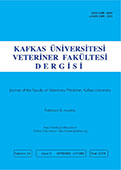
This journal is licensed under a Creative Commons Attribution-NonCommercial 4.0 International License
Kafkas Üniversitesi Veteriner Fakültesi Dergisi
2018 , Vol 24 , Issue 5
Optimization of Culture Conditions for High Cell-Density Fermentation of Bovine Escherichia coli
1Post-doctoral Scientific Research Workstation, Shandong Binzhou Animal Science and Veterinary Medicine Academy, Binzhou 256600, P.R. CHINA2Shandong Lvdu Bio-science and Technology Co. Ltd., Binzhou 256600, P.R. CHINA
3College of Animal Science and Veterinary Medicine, Henan Institute of Science and Technology, Xinxiang 453003, P.R. CHINA
4Institution of Animal Science and Veterinary Medicine, Shandong Academy of Agricultural Science, Jinan 250000, P.R. CHINA DOI : 10.9775/kvfd.2018.19884 Bovine Escherichia coli infection, which causes major economic losses to the cattle industry each year, can be prevented by administering formalin-inactivated vaccine. However, to enhance the application of this vaccine, the cell density of the formalin-inactivated E. coli should be boosted. This can be achieved by reducing the accumulation of acetate, a primary inhibitory metabolite in E. coli fermentation. To this end, the present study investigated the effect of pH, dissolved oxygen (DO) levels, and feeding methods on bovine E. coli fermentation, and developed two-stage pH and DO control strategies and a combined pH- and DO-mediated feeding strategy for the fermentation. The optimized conditions for Bovine E. coli were pH 7.0 at 0-10 h, 6.5 at 10-24 h; DO 50% at 0-10 h, 30% at 10–24 h; pH and DO feedback feeding at 0-10 h and 10-24 h, respectively. With Bovine E. coli fermentation under the optimized conditions, the acetate accumulation was 1.12 g/L and the cell density was 36.47 (OD600), which were 59.12% lower and 77.29% higher than these with the original conditions (pH 7.0; DO 20%; residual glucose concentration maintained at 2.0 g/L). After analyzing the main nodes of acetate synthesis, it was found that the lower carbon flux enters the Embden-Meyerhof pathway. Under the optimized conditions, the pyruvate flux and acetyl-CoA synthesis were low, and much of the acetyl-CoA participated in the tricarboxylic acid cycle. The extracellular acetate flux was 8.3%, which was 65.13% lower than in the original conditions. Keywords : Escherichia coli, acetate, dissolved oxygen, feeding strategy, metabolic flux distribution










